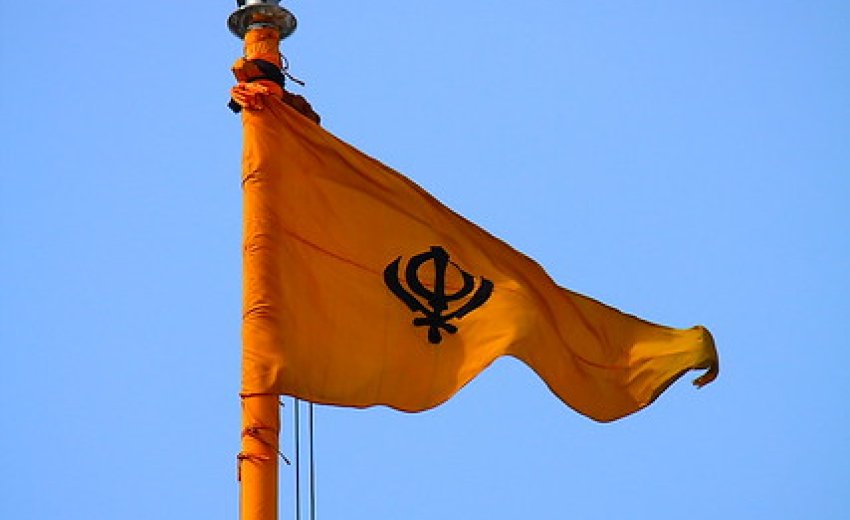Legend has it that before the Nishan Sahib could touch the ground, Guru Gobind Singh Ji's son, Sahibzada Baba Ajit Singh Ji, swiftly grabbed hold of it and raised it high.
The Nishan Sahib represents Sikhs in body, mind, and action. It declares their physical, mental, and spiritual independence, emphasizing unity under its protection. It signifies the purity of their thoughts and spiritual elevation through belief in one God, faith in their Gurus, Guru Granth Sahib ji, and the principles of the Sikh faith, including the discipline of Amrit. It showcases their faith, beliefs, high morale, honest conduct, hard work, truthfulness, justice, forgiveness, equality, liberty, compassion, and helpfulness to the needy.
Watching a gently fluttering flag fills the mind with joy.
A tale of glory and reverence
During the second battle of Anandpur Sahib, a brave Sikh named Bhai Alam Singh, who was carrying the Nishan Sahib, was captured by the Mughals. Despite advancing far beyond the Sikh positions, Bhai Alam Singh held the fluttering Sikh flag, displaying unwavering pride and fearlessness. Soon, enemy Mughal soldiers surrounded him. The Mughal commander ordered Bhai Alam Singh to throw down the Nishan Sahib flag. However, Bhai Alam Singh refused, saying "This Flag is the symbol of my personal dignity and that of my Guru and I will never let it fall". He was determined to protect the sacred flag at all costs, even if it meant sacrificing his life. The flag held immense significance as a symbol of the Sikh faith and identity. Bhai Alam Singh's courage and devotion in the face of the enemy were truly remarkable.
The Mughal Commander then says "we will cut off your hands, in that case."
To this threat, Bhai Alam Singh Ji replied with utmost courage that if that happens, he will carry the Nishan Sahib with his feet. The Mughals threatened to cut his legs too.
Bhai Alam Singh Ji boldly defying, responded, "Then, I will hold it between my lips, with my mouth! This flag belongs to my GURU, I will never let it fall ever"
The commander angrily said they'd blow the person's head off and asked what he'd do then. Bhai Alam Singh Ji calmly replied that in such a situation, the Guru whose flag he carried would take care of it, but as long as he was alive, he'd hold it high. Back then, in war, it was a rule not to harm flag bearers. However, the Mughal commander, witnessing Bhai Alam Singh's fearless defiance, disregarded this rule and swiftly beheaded him,violating the agreed rules of battle engagement.
Legend has it that before the Nishan Sahib could touch the ground, Guru Gobind Singh Ji's son, Sahibzada Baba Ajit Singh Ji, swiftly grabbed hold of it and raised it high. With one hand on the Nishan Sahib, he swiftly struck down the head of the Mughal Commander, causing fear and disorder among the enemy ranks. This event illustrates the high regard Sikhs held for the Nishan Sahib during those times.
What is Nishan Sahib?
The Nishan Sahib is a special flag in Sikhism. It's a triangle-shaped flag made of cotton or silk, usually with a tassel hanging from it. You'll often see it flying on a tall pole outside Sikh temples, called Gurdwaras. The flag has an orange background with the Khanda symbol in the middle.
At most Gurdwaras, you'll find the Nishan Sahib flying high on a tall pole covered in fabric that matches the flag's color. It's topped with the Khanda symbol. The Khanda is made up of a double-edged sword in the center, surrounded by a circular chakkar, and flanked by two single-edged swords, called kirpans.
In the past, many Sikh warriors used to wear this symbol, and some still do today. It's different from another symbol called Aad Chand, which was the original symbol of the Khalsa, a group of initiated Sikhs. Originally, the Khanda flag was plain yellow, not the way we see it today. The Nishan Sahib is a powerful symbol for the Khalsa Panth, showing that Sikhs are present in the area. Every year during the Baisakhi festival, which is in mid-April, the flag is taken down and replaced with a new one, and the flagpole gets a fresh look.
Inscribing on Nishan Sahib
It is said that the words "Waheguru Ji Ki Fateh" in Punjabi script, meaning "Victory of God," were written on the Nishan Sahib of Guru Gobind Singh Ji. During the time of Maharaja Ranjit Singh, the words "Akal Sahai" in Punjabi script were added to the Nishan Sahib. Back in the times of Sikh Misals, the "Nishan Walia" Misal was responsible for providing Sikhs with Nishan Sahibs to carry during battles. Today, a Nishan Sahib, which is a flag on a pole of suitable height, is raised at all Gurdwaras.
In front of Akal Takht Sahib, there are two Nishan Sahibs. One of them, the Jhanda Sahib, is shorter by one foot compared to the other one facing Darbar Sahib. This shorter one symbolizes the spiritual or Heavenly realm, which is considered more significant.
*Based on an article published in Tuhitu Blogs on 2nd July 2013
